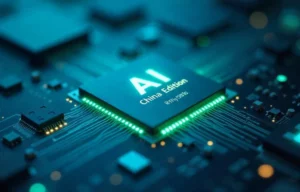

Prefer to listen instead? Here’s the podcast version of this article.
Cryptocurrency has taken the financial world by storm in recent years. Cryptocurrency’s rapid growth has pushed tech evangelists to consider the digital currency’s underlying technology, blockchain. Some experts argue blockchain technology will eventually power the internet via and digital worlds like the metaverse. But what is blockchain, how does it work, and can it truly be the framework of the future? Let’s find out.
A blockchain is a growing list of records or ledgers stored across a peer-to-peer network, joined by strong cryptography. Each block contains a cryptographic hash of the previous block (this is how two blocks are connected), a time-stamp of the transaction that the block represents, and additional transaction data. Instead of the traditional way of storing transaction data in a single, central computer, blockchains store replicas of a particular database across various computers in a network. These computers and devices in a network are called nodes.
Blockchain is a portmanteau involving block (the data/transaction chunk) and chain (the cryptographic link connecting the blocks). A new block is created whenever new data is added to a network. Then, all nodes in the network update their version of the blockchain ledger to include this new block.
Blockchains are immutable, which means a single entity cannot change the data in the blocks. New blocks are only added to a chain when a consensus is reached by most nodes in a network, which is done by verifying and confirming whether the new data is valid. Strong cryptography adds additional security at the node level when processing a transaction. Lastly, since each block contains the cryptographic hash of the previous block, blockchains can be traced from the most recent transaction to the first transaction.
There are two types of blockchains; private and public. Public blockchains allow anyone in a network to read, write and inspect data. On the other hand, private blockchains are regulated by an organization or a group.
There are multiple tangible benefits of using Blockchain technology, including:
The public Blockchain platform has helped develop many products over the years. Some of which include:
Cryptocurrencies are perhaps the best showcase for public blockchain technology. An all-digital currency, crypto uses a public mesh of tokens connected through encrypted trails of data, similar to a ledger. Like blockchain, cryptocurrency is not centrally stored but is spread into tokens that hold monetary value. Bitcoin and Ethereum are the world’s most popular cryptocurrencies, with Ethereum recently driving innovation in the public blockchain domain.
Another product of blockchain technology are NFTs. NFTs represent decentralized, tokenized forms of digital content. They can be original artworks, videos, songs, documents, and more. Each NFT and its ownership is represented as a token that can be bought, sold, or traded. The proliferation of NFTs and NFT marketplaces has helped digital creators sell their art directly to consumers without third-party regulatory platforms acting as middlemen. Blockchain NFTs have become so popular that organizations that typically sell physical products are now selling NFTs to reach more customers.
Public, peer-to-peer (directly between two users without routing via a centralized system) blockchain technology has created a platform that many developers use to create decentralized applications (DApps). A large portion of DApps is targeted towards creating alternatives to traditional banking, lending, and financial apps. DeFi apps utilize blockchain mesh networks to provide more accessible, secure, and efficient solutions that do not require paperwork or third-party verification. These DeFi apps are also free from traditional governing authorities like banks, brokerages, or exchanges. DeFi is also pseudonymous and open to all.
One of the most ambitious projects utilizing blockchain technology is the metaverse—a digital replica of our ever-expanding social universe, replete with marketplaces, interactive experiences, and more. The metaverse strives to be a virtual living space for everyone, built on public blockchains to provide less regulation and instant accessibility globally. Digital avatar represents users in the metaverse. Interactions with other avatars, entities, platforms, and stores can be 100% digital or a hybrid of the virtual and real-world.
The current version of the internet is dubbed Web2. It is an ecosystem of consumers and creators built on a mixture of static and dynamic content. Web2 is heavily regulated through internet providers like Comcast and Jio, service providers like Meta, Google, and Amazon, and authorities like governments. Web3 builds on blockchain technology’s public and accessible nature (largely the Ethereum platform) to provide a public internet void of regulation. In Web3, data is user-owned and controlled, transactions are based on cryptocurrency and peer-to-peer networks, and transmissions are strong-encrypted. Web3 will be faster, decentralized, and not owned by a single entity.
The buzz around decentralized products like cryptocurrency, NFTs, and DeFi has brought blockchain to the forefront of emerging technologies. Furthermore, other projects like the metaverse and Web3 place an even greater emphasis on blockchain technology. For blockchain to transition to mainstream relevance, the ambitious undertakings need to deliver on their promises and iron out bugs, performance, and security issues. With big corporations like Google, Meta, and Microsoft interested in developing solutions using blockchain, a future of public, accessible-to-all technologies may be here sooner than we expect.
WEBINAR